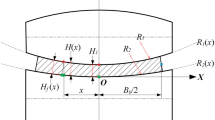Abstract
Flexible rolling is a novel and effective process for double curvature parts and it is suitable for various shapes and small batch production. Taking spherical surface parts as an example, the utilization rate of the processed curvature part in flexible rolling was studied for the first time. In the finite element model, the processed surface part is divided into three areas by forming characteristics. The formation mechanisms of forming areas are discussed. Meanwhile, the effect of the ratio among length, width, and thickness on the utilization rate of processed surface part is studied deeply. The results show that the processed surface part is divided into three areas by plastic deformation in the longitude direction. The bending deformation distribution is continuously changing in the transition-forming areas and stable in the stable-forming area. The ratio among the length, width, and thickness has a great effect on the utilization rate of processed surface part. When the width and thickness remain constant, the utilization rate is increasing with increasing length ratio. When the length and thickness remain constant, the utilization rate is increasing with decreasing width ratio. When the length and width remain constant, the utilization rate is increasing with decreasing thickness ratio. The numerical simulation results are in accord with experiment results.
Similar content being viewed by others
References
Aerens R, Eyckens P, Van Bael A, Duflou JA (2010) Force prediction for single point incremental forming deduced from experimental and FEM observations. Int J Adv Manuf Technol 46:969–982
Ambrogio G, Filice L, Guerriero F, Guido R, Umbrello D (2011) Prediction of incremental sheet forming process performance by using a neural network approach. Int J Adv Manuf Technol 54:921–930
Li Q, Lovell M (2008) Cross wedge rolling failure mechanisms and industrial application. Int J Adv Manuf Technol 37:265–278
Wang MH, Xiang D, Xiao C, Zhou J, Jia Z (2012) Influence of cooling condition of tools on central deformation of workpiece and tool wear in cross wedge rolling. Int J Adv Manuf Technol 59:473–482
Richter-Trummer V, Koch D, Witte A, Dos Santos JF, De Castro PMST (2013) Methodology for prediction of distortion of work pieces manufactured by high speed machining based on an accurate through-the-thickness residual stress determination. Int J Adv Manuf Technol 68:2271–2281
Li QH, Wu LB, Li FG, Liu TY, Wang SG, Wei ZJ, Su CM (2013) Experiments study on the rolling process for heavy disk. Int J Adv Manuf Technol 65:1171–1175
Yoon SJ, Yang DY (2003) Development of a highly flexible incremental roll forming process for the manufacture of a doubly curved sheet metal. CIRP Ann Manuf Technol 52(1):201–204
Yoon SJ, Yang DY (2005) An incremental roll forming process for manufacturing doubly curved sheets from general quadrilateral sheet blanks with enhanced process features. CIRP Ann Manuf Technol 54(1):221–224
Shim DS, Yang DY, Kim KH, Han MS, Chung SW (2009) Numerical and experimental investigation into cold incremental rolling of doubly curved plates for process design of a new LARS (line array roll set) rolling process. CIRP Ann Manuf Technol 58(1):239–242
Shim DS, Yang DY, Kim KH, Chung SW, Han MS (2010) Investigation into forming sequences for the incremental forming of doubly curved plates using the line array roll set (LARS) process. Int J Mach Tools Manuf 50:214–218
Hu ZQ, Li MZ, Cai ZY, Gong XP (2009) Continuous flexible forming of three-dimensional surface parts using bendable rollers. Mat Sci Eng A-Struct 499:234–237
Gong XP, Li MZ, Hu ZQ, Cai ZY (2010) Research on continuous multi-point forming technology for three-dimensional sheet metal. Int J Mater Prod Tec 38:210–222
Cai ZY, Li MZ, Lan YW (2012) Three-dimensional sheet metal continuous forming process based on flexible roll bending: principle and experiments. J Mater Process Technol 212:120–127
Li MZ, Cai ZY, Li RZ, Lan YW, Qiu NJ (2012) Continuous forming method for three-dimensional surface parts based on the rolling process using bended roll. Chin J Mech Eng 48:44–49 (in Chinese)
Cai ZY, Li MZ (2013) Principle and theoretical analysis of continuous roll forming for three-dimensional surface parts. Sci China Tech Sci 2:351–358
Wang DM, Li MZ, Cai ZY (2014) Research on forming precision of flexible rolling method for three-dimensional surface parts through simulation. Int J Adv Manuf Technol 71:1717–1727
Wang DM, Li MZ, Cai ZY (2014) Continuous-forming method for three-dimensional surface parts combining rolling process with multipoint-forming technology. Int J Adv Manuf Technol 72:201–207
Author information
Authors and Affiliations
Corresponding author
Rights and permissions
About this article
Cite this article
Li, Y., Li, M. & Liu, K. Study on the utilization rate of processed spherical surface part in flexible rolling. Int J Adv Manuf Technol 100, 3207–3218 (2019). https://doi.org/10.1007/s00170-018-2905-x
Received:
Accepted:
Published:
Issue Date:
DOI: https://doi.org/10.1007/s00170-018-2905-x




